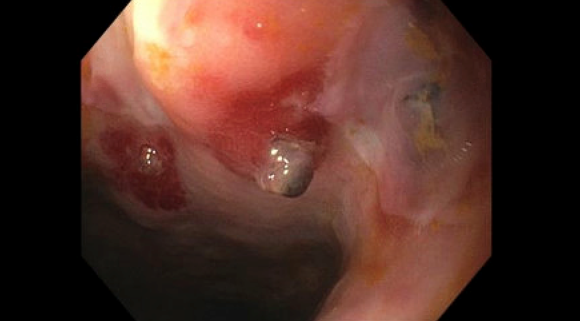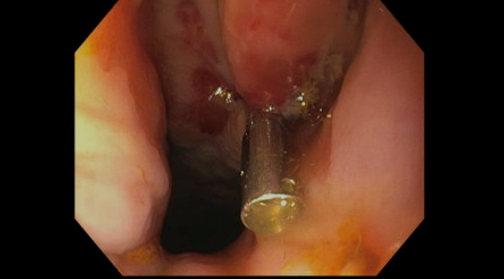Sunday Poster Session
Category: GI Bleeding
P0966 - Biopsy Backfire: Large Volume Rectal Bleeding Following Transrectal Prostate Biopsy
Sunday, October 26, 2025
3:30 PM - 7:00 PM PDT
Location: Exhibit Hall
- AM
Annabel Moore, MD
University of Kentucky
Lexington, KY
Presenting Author(s)
Annabel Moore, MD, Yan Chu, MD, Marijeta Pekez, MD
University of Kentucky, Lexington, KY
Introduction: Transrectal ultrasound (TRUS) guided prostate biopsy is the gold standard for prostate cancer diagnosis in men. Mild and self-limited rectal bleeding is a frequently cited complication, while symptomatic blood loss necessitating endoscopic intervention is rarely encountered. Endoscopic interventions include sclerotherapy, epinephrine injection, hemoclip application, band ligation, and electrocautery. We present a case of severe rectal bleeding following a transrectal prostate biopsy, successfully managed with endoscopic clipping.
Case Description/
Methods: An 86-year-old male with a history of abdominal aortic aneurysm repair on clopidogrel, coronary artery disease, and benign prostatic hyperplasia presented to the emergency department due to significant hematochezia that began six hours after undergoing TRUS prostate biopsy. His blood pressure was 60/40 and heart rate was 140 with a hemoglobin of 9.1 g/dL (12.5 g/dL at baseline). Computed tomography angiography showed contrast in the rectal vault with no active extravasation. Clopidogrel had been held 7 days prior to admission, and no anticoagulation or venous thrombosis prophylaxis was given. He was given one unit of blood. However, he continued to have hematochezia, with further hemoglobin decrease to 7.0 g/dL. Flexible sigmoidoscopy was urgently performed, which demonstrated localized erythematous mucosa with a visible vessel in the rectum (Figure 1). A hemostatic clip was deployed, achieving hemostasis. Clopidogrel was resumed without further bleeding or other complications. He was discharged home with urology follow-up.
Discussion: Severe rectal bleeding requiring intervention occurs in fewer than 1% of prostate biopsies. Both immediate and delayed hematochezia have been reported. Reporting such cases is essential for identifying effective interventions and relevant risk factors such as anticoagulant/antiplatelet use and the number/location of core biopsies taken. Fortunately, multiple endoscopic techniques are available to achieve hemostasis; in this case, hemostatic clip deployment proved effective. Radiological embolization and surgical approaches are alternative options for management. The low reported incidence may reflect under-recognition or underreporting, as most data is derived from isolated case reports. By documenting this case, we aim to contribute to the existing literature, enhance clinical understanding, and support interventionalists in managing this uncommon but potentially serious complication.

Figure: Figure 1: Visible vessel located in the rectum with localized erythematous mucosa and stigmata of recent hemorrhage

Figure: Figure 2: Successfully placed hemostatic clip over the visible vessel
Disclosures:
Annabel Moore indicated no relevant financial relationships.
Yan Chu indicated no relevant financial relationships.
Marijeta Pekez indicated no relevant financial relationships.
Annabel Moore, MD, Yan Chu, MD, Marijeta Pekez, MD. P0966 - Biopsy Backfire: Large Volume Rectal Bleeding Following Transrectal Prostate Biopsy, ACG 2025 Annual Scientific Meeting Abstracts. Phoenix, AZ: American College of Gastroenterology.
University of Kentucky, Lexington, KY
Introduction: Transrectal ultrasound (TRUS) guided prostate biopsy is the gold standard for prostate cancer diagnosis in men. Mild and self-limited rectal bleeding is a frequently cited complication, while symptomatic blood loss necessitating endoscopic intervention is rarely encountered. Endoscopic interventions include sclerotherapy, epinephrine injection, hemoclip application, band ligation, and electrocautery. We present a case of severe rectal bleeding following a transrectal prostate biopsy, successfully managed with endoscopic clipping.
Case Description/
Methods: An 86-year-old male with a history of abdominal aortic aneurysm repair on clopidogrel, coronary artery disease, and benign prostatic hyperplasia presented to the emergency department due to significant hematochezia that began six hours after undergoing TRUS prostate biopsy. His blood pressure was 60/40 and heart rate was 140 with a hemoglobin of 9.1 g/dL (12.5 g/dL at baseline). Computed tomography angiography showed contrast in the rectal vault with no active extravasation. Clopidogrel had been held 7 days prior to admission, and no anticoagulation or venous thrombosis prophylaxis was given. He was given one unit of blood. However, he continued to have hematochezia, with further hemoglobin decrease to 7.0 g/dL. Flexible sigmoidoscopy was urgently performed, which demonstrated localized erythematous mucosa with a visible vessel in the rectum (Figure 1). A hemostatic clip was deployed, achieving hemostasis. Clopidogrel was resumed without further bleeding or other complications. He was discharged home with urology follow-up.
Discussion: Severe rectal bleeding requiring intervention occurs in fewer than 1% of prostate biopsies. Both immediate and delayed hematochezia have been reported. Reporting such cases is essential for identifying effective interventions and relevant risk factors such as anticoagulant/antiplatelet use and the number/location of core biopsies taken. Fortunately, multiple endoscopic techniques are available to achieve hemostasis; in this case, hemostatic clip deployment proved effective. Radiological embolization and surgical approaches are alternative options for management. The low reported incidence may reflect under-recognition or underreporting, as most data is derived from isolated case reports. By documenting this case, we aim to contribute to the existing literature, enhance clinical understanding, and support interventionalists in managing this uncommon but potentially serious complication.

Figure: Figure 1: Visible vessel located in the rectum with localized erythematous mucosa and stigmata of recent hemorrhage

Figure: Figure 2: Successfully placed hemostatic clip over the visible vessel
Disclosures:
Annabel Moore indicated no relevant financial relationships.
Yan Chu indicated no relevant financial relationships.
Marijeta Pekez indicated no relevant financial relationships.
Annabel Moore, MD, Yan Chu, MD, Marijeta Pekez, MD. P0966 - Biopsy Backfire: Large Volume Rectal Bleeding Following Transrectal Prostate Biopsy, ACG 2025 Annual Scientific Meeting Abstracts. Phoenix, AZ: American College of Gastroenterology.
